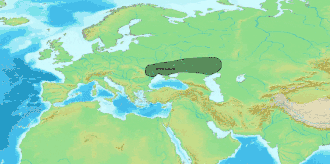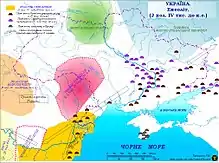Dnieper–Donets culture
The Dnieper–Donets culture (ca. 5th—4th millennium BC) was a Mesolithic and later Neolithic culture which flourished north of the Black Sea ca. 5000-4200 BC. It has many parallels with the Samara culture, and was succeeded by the Sredny Stog culture.[2]
 | |
| Geographical range | North of the Black Sea |
|---|---|
| Dates | c. 5000 BC – 4200 BC |
| Preceded by | Swiderian culture |
| Followed by | Sredny Stog culture[1] |
| Part of a series on |
| Indo-European topics |
|---|
 |

Discovery
The Dnieper–Donets culture was defined by the Soviet archaeologist Dmytro Telehin (Dmitriy Telegin)[3][4] on proposition of another archaeologist Valentyn Danylenko in 1956. At that time Dmytro Telehin worked at the Institute of Archaeology of the Academy of Sciences of the Ukrainian SSR (1952 – 1990).[5] In 1967 Telehin defended his doctorate dissertation "Dnieper–Donets Neolithic culture".[5]
Origin
The origins of the Dnieper–Donets culture are found in the Swiderian culture. Its people traced their origins to earlier Mesolithic foragers.[3]
The Dnieper–Donets culture appeared in the early fifth millennium BC along the middle Dnieper to the northern Donets. It quickly expended in all directions, eventually absorbing all other local Neolithic groups.[6]
Distribution
The Dnieper–Donets culture was distributed in the areas north of the Black Sea. Throughout is existence rapid population growth and an expansion towards the steppe is noticeable.[6]
There are parallels with the contemporaneous Samara culture to the north.[7][8] Striking similarities with the Khvalynsk culture and the Sredny Stog culture have also been detected.[7] A much larger horizon from the upper Vistula to the lower half of Dnieper to the mid-to-lower Volga has therefore been drawn.[9]
Influences from the Dnieper–Donets culture and the Sredny Stog culture on the Funnelbeaker culture have been detected.[10] An origin of the Funnelbeaker culture from the Dnieper–Donets culture has been suggested, but this is very controversial.[10]
The Dnieper–Donets culture was contemporary with the Bug–Dniester culture.[11] It is clearly distinct from the Cucuteni–Trypillia culture.[12][13]
Characteristics
Settlements
The Dnieper–Donets culture is known from more than 200 sites.[6] Few settlements from the Dnieper–Donets culture are known, but a few semi-subterranean huts have been found.[9] These huts were covered in bark.[3]
Economy
The Dnieper–Donets culture was originally a hunter-gatherer culture. The economic evidence from the earliest stages is almost exclusively from hunting and fishing.[6] Among the sources of food hunted and foraged by the Dnieper-Donets people were aurochs, elk, red deer, roe, wild boar, fox, wildcat, hare, bear and onager.[6] Their diet was primarily high protein, with meat, fish and nuts being consumed.[9]
From around 5200 BC, the Dnieper-Donets people began keeping cattle, sheep and goat.[3] Other domestic animals kept included pig, horse and dog.[6] During the following centuries, domestic animals from the Dnieper further and further east towards the Volga-Ural steppes, where they appeared ca. 4700-4600 BC. From about 4200 BC, the Dnieper–Donets culture adopted agriculture.[3] Domestic plants that have been recovered include millet,[14] wheat and pea.[9] Evidence from skeletal remains suggest that plants were consumed.[9]
The presence of exotic goods in Dnieper-Donets graves indicates exchange relationships with the Caucasus.[6]
Art
The Dnieper–Donets culture produced no female figurines.[3]
Burials
The Dnieper–Donets culture is well known for about thirty of its cemeteries that have been discovered. These contain around 800 individuals.[9] It is evident that funerals were complex events that had several phases.[3]
Burials are mostly in large pits where the deceased were periodically placed and covered with ocher.[9] The deceased was typically exposed for a time before their bones were collected and buried. On other occasions the ceased was buried in the flesh without exposure. Deceased Dnieper-Donets people sometimes had only their skulls buried, at other times the entire bodies. The variants of Dnieper-Donets burial often appear in the same pits. Animal bones has also been found in the graves.[3]
Certain Dnieper-Donets burials are accompanied with copper, crystal or porphyry ornaments, shell beads, bird-stone tubes, polished stone maces or ornamental plaques made of boar's tusk. The items, along with the presence of animal bones and sophisticated burial methods, appear to have been a symbol of power. Certain deceased children were buried with such items, which indicates that wealth was inherited in Dnieper-Donets society. Very similar boar-tusk plaques and copper ornament have been found at contemporary gravesof the Samara culture in the middle Volga area.[3][15] Maces of a different type than those of Dnieper-Donets have also been found. The wide adoption of such a status symbol attests to a change in the politics of power.[3]
In later times the deceased in the Dnieper–Donets culture were sometimes buried individually.[9] This shift has been suggested as evidence of a shift towards increasing individualism.[1]
Dnieper–Donets burials have been found near the settlement of Deriivka, which is associated with the Sredny Stog culture.[16]
Tools
The Dnieper–Donets culture continued using Mesolothic technology, but later phases see the appearance of polished stone axes, later flint and the disappearance of microliths.[6] These tools were sometimes deposited in graves.[3]
Pottery
Dnieper-Donets pottery was initially pointed based, but in later phases flat-based wares emerge.[6] Their pottery is completely different from those made by the nearby Cucuteni–Trypillia culture. The importance of pottery appears to have increased throughout the existence of the Dnieper–Donets culture, which implies a more sedentary lifestyle.[3]
The early use of typical point base pottery interrelates with other Mesolithic cultures that are peripheral to the expanse of the Neolithic farmer cultures. The special shape of this pottery has been related to transport by logboat in wetland areas. Especially related are Swifterbant in the Netherlands, Ellerbek and Ertebølle in Northern Germany and Scandinavia, "Ceramic Mesolithic" pottery of Belgium and Northern France (including non-Linear pottery such as La Hoguette, Bliquy, Villeneuve-Saint-Germain), the Roucadour culture in Southwest France and the river and lake areas of Northern Poland and Russia.[17]
Linguistics
The Dnieper–Donets culture is situated in the area which in accordance with the Kurgan hypothesis has been suggested as the Proto-Indo-European homeland. It has been suggested that the Dnieper-Donets people were Pre–Indo-European-speakers who were absorbed by Proto-Indo-Europeans expanding westwards from steppe-lands further east.[9]
The Dnieper-Donets people almost certainly spoke a different language from the people of the Cucuteni–Trypillia culture.[3]
The areas of the upper Dniester in which the Dnieper–Donets culture was situated have mostly Baltic river names. That and the close relationship between the Dnieper–Donets culture and contemporary cultures of northeast Europe have caused the Dnieper–Donets culture to be identified with the later Balts.[9]
Mallory includes that area within the limits of the Proto-Indo-Europeans. The precise role of the culture and its language to the derivation of the Pontic-Caspian cultures, such as Sredny Stog and Yamnaya culture, is open to debate, but the display of recurrent traits points to longstanding mutual contacts or to underlying genetic relations.[18]
Physical type
The physical remains recovered from graves of the Dnieper–Donets culture have been classified as "Proto-Europoid".[9][lower-alpha 1] They are predominantly characterized as late Cro-Magnons[19] with large and more massive features than the gracile Mediterranean peoples of the Balkan Neolithic.[6][20] Males averaged 172 cm in height, which is much taller than contemporary Neolithic populations.[6] Its rugged physical traits are thought to have genetically influenced later Indo-European peoples.[9][20]
Physical anthropologists have pointed out similarities in the physical type of the Dnieper-Donets people with the Mesolithic peoples of Northern Europe.[9]
The peoples of the neighboring Sredny Stog culture, which eventually succeeded the Dnieper–Donets culture, were of a more gracile appearance.[21]
Genetics
A genetic study published in Nature in February 2018 included an analysis of 32 individuals from three Eneolithic cemeteries at Deriivka, Vilnyanka and Vovnigi,[22] which are ascribed to the Dnieper–Donets culture.[23] These individuals belonged exclusively to the paternal haplogroups R and I (mostly R1b and I2), and almost exclusively to the maternal haplogroup U (mostly U5, U4 and U2). This suggests that the Dnieper-Donets people were "distinct, locally derived population" of mostly of Eastern Hunter-Gatherer (EHG) descent, with Western Hunter-Gatherer (WHG) admixture. The WHG admixture appears to have increased in the transition from the Meslothic to the Neolithic.[24] Unlike the Yamnaya culture, whose genetic cluster is known as Western Steppe Herder (WSH), no Caucasian Hunter-Gatherer (CHG) or Early European Farmer (EEF) ancestry has been detected in the Dnieper–Donets culture.[23] At the Vilnyanka cemetery, all the males belong to the paternal haplogroup I, which is common among WHGs. David W. Anthony suggests that this influx of WHG ancestry might be the result of EEFs pushing WHGs out of their territories to the east, where WHG males might have mated with EHG females.[24]
Dnieper-Donets males and Yamnaya males carry the same paternal haplogroups (R1b and I2a), suggesting that the CHG and EEF admixture among the Yamnaya came through EHG and WHG males mixing with EEF and CHG females. According to Anthony, this suggests that the Indo-European languages were initially spoken by EHGs living in Eastern Europe[25]
Successors
The Dnieper–Donets culture was succeeded by the Sredny Stog culture, its eastern neighbor, with whom it co-existed for a time before being finally absorbed.[1][26] The Dnieper–Donets culture and the Sredny Stog culture were in turn succeeded by the Yamnaya culture.[20] The Mikhaylovka culture, the Novodanilovka group and the Kemi Oba culture displays evidence of continuity from the Dnieper–Donets culture.[27]
See also
| Wikimedia Commons has media related to Dnieper–Donets culture. |
Notes
- Images of reconstructions of a male and female from the Dnieper-Donets culture are printed in Mallory, J. P. (1991). In Search of the Indo-Europeans: Language Archeology and Myth. p. 175.[19]
References
- Mallory 1991, p. 210.
- Mallory 1991, pp. 174-182.
- Anthony 2007, pp. 174-182.
- Anthony 2007, p. 240.
- Svitlana Yurenko. Dmytro Yakovych Telehin (ТЕЛЕГІН ДМИТРО ЯКОВИЧ). Encyclopedia of History of Ukraine.
- Mallory 1991, pp. 190-191.
- Mallory 1991, pp. 206-207.
- Mallory 1997, p. 498.
- Mallory 1997, pp. 166-167.
- Mallory 1991, p. 252.
- Anthony 2007, p. 155.
- Anthony 2007, p. 104.
- Anthony 2007, pp. 173-174.
- Mallory 1997, p. 384.
- Anthony 2007, p. 189.
- Mallory 1997, p. 157.
- de Roever 2004, pp. 162-163.
- Mallory 1991, p. 197.
- Mallory 1991, p. 175.
- Kuzmina 2007, p. 384.
- Mallory 1991, p. 201.
- Mathieson 2018.
- Anthony 2019a, p. 14.
- Anthony 2019b, p. 39.
- Anthony 2019a, pp. 7, 14.
- Mallory 1997, p. 399.
- Mallory 1991, p. 206.
Bibliography
- Anthony, David W. (2010). The Horse, the Wheel, and Language: How Bronze-Age Riders from the Eurasian Steppes Shaped the Modern World. Princeton University Press. ISBN 978-1-4008-3110-4.
- Anthony, David (Spring–Summer 2019a). "Archaeology, Genetics, and Language in the Steppes: A Comment on Bomhard". Journal of Indo-European Studies. 47 (1–2). Retrieved January 9, 2020.
- Anthony, David W. (2019b). "Ancient DNA, Mating Networks, and the Anatolian Split". In Serangeli, Matilde; Olander, Thomas (eds.). Dispersals and Diversification: Linguistic and Archaeological Perspectives on the Early Stages of Indo-European. BRILL. pp. 21–54. ISBN 978-9004416192.
- de Roever, Jutta Paulina (2004). Swifterbant-aardewerk: Een analyse van de neolithische nederzettingen bij Swifterbant, 5e millennium voor Christus (PDF) (in Dutch). Barkhuis. Archived from the original (PDF) on February 27, 2008. Retrieved January 5, 2020.
- Kuzmina, Elena E. (2007). Mallory, J. P. (ed.). Encyclopedia of Indo-European Culture. BRILL. ISBN 978-9004160545.
- Mallory, J. P. (1991). In Search of the Indo-Europeans: Language Archeology and Myth. Thames & Hudson.
- Mallory, J. P.; Adams, Douglas Q. (1997). Encyclopedia of Indo-European Culture. Taylor & Francis. ISBN 1884964982.
- Mathieson, Iain (February 21, 2018). "The Genomic History of Southeastern Europe". Nature. Nature Research. 555 (7695): 197–203. Bibcode:2018Natur.555..197M. doi:10.1038/nature25778. PMC 6091220. PMID 29466330. Retrieved January 7, 2020.